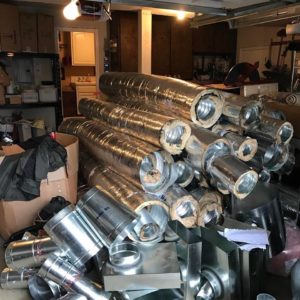Flexible Ductwork Vs. Rigid Ductwork
When it comes to our homes, we always try to put in as much effort as possible. In all aspects, from the conception, construction, and the designing of our homes, it’s completely normal to overthink every possible detail. The same can also be said about HVAC, (Heating, Ventilation, and Air Conditioning). A lot of people overlook this process. If you’re one of those people, surely you also do not know a lot about the design, materials, and the details of an HVAC system.
In order to properly install a brand new HVAC system, you need to have extensive knowledge on the different types of ductwork. With proper information, you can correctly design your HVAC system with ductwork that suits your needs. One very important aspect of duct design to consider is the differences between flexible HVAC ductwork and rigid duct insulation. They are two completely different types of ducts and they both have their pros and cons.
This article will talk about the two types of ductwork; the rigid ductwork, and the flex ductwork, the pros and cons of each other, and any other information to help you in deciding what kind of ductwork is appropriate for your home.
What Is Ductwork?
Ducts are the conduit or the passageways that you use in an HVAC (Heating, Ventilation, Air Conditioning) System. Their main purpose is to deliver and remove air. In HVAC, you use air ducts to evenly distribute air at different temperatures from your cooling or heating system. This process involves taking in air from the house, cooling or heating it, and then returning it into your home.
Whenever you are undertaking a remodeling or a construction project, this is a major detail that you should not overlook. Some people make the common mistake of not thinking much about ductwork installation and regretting it at the end. Without properly designed ducts, the overall equilibrium of your heating and cooling systems will be off and your home’s efficiency and climate control will suffer in the end.
Rigid and Flex Ductwork
We have talked about ducts being a channel from your HVAC system throughout your home. Now, there are two major types of air ducts that you can choose depending on what you want and need. These are rigid ductwork and flex ductwork. Both types of ductwork have specific features, pros, cons, and specifications.
Flexible HVAC Ductwork
This type of ductwork is usually tube shaped and is made from a wire coil covered in a bendable but durable plastic. Manufacturers then cover the tube in fiberglass insulation. Using this kind of ducting is best in tricky spaces where rigid ducts are not just possible to install. They are also used to install ductwork which is not flexible to a certain air supply outlet. Flexible ductwork uses cheaper materials and therefore is a cheaper option.
Rigid HVAC Ductwork
Rigid ductwork comes in a variety of shapes, materials, and sizes. This type of ductwork can either be rectangular or cylindrical, and consists of a solid material wrapped in insulation. Rigid ductwork is known to be enduring and reliable. They are generally a more expensive option, but you get a higher quality air duct that doesn’t make as much noise when air is running through it. Here are some of the types of rigid ductwork:
- Fiber Board Ducts. Made from compressed fiberglass strands which are bonded with resin, and covered with a foil laminate for moisture protection.
- Fiber Glass Lined Ducts. Made from sheet metal ducts with internal and external fiberglass lining.
- Sheet Metal Ducts. The most common materials used for sheet metal ducts are aluminum and galvanized steel. These are the kinds of ducts you have seen in movies that a person crawls through.
Pros and Cons
Like most parts of an HVAC system, ductwork also has specific installation requirements. There are many differences between flexible HVAC ductwork and rigid duct insulation. Here are some details of each type:
Flex Ductwork
- It’s important to install flexible ductwork properly and with as little snaking or sagging as possible. The ductwork itself needs to be totally secure and supported.
- Turns, bends, and kinks, needs to be minimized as much as possible as this can affect the air flow and efficiency of the HVAC system
- Flexible ducts are fairly easy to install and will often cost less than the rigid ductwork.
Rigid Ductwork
- Sheet metal ducts are less likely to incur dangerous mold and growths because their surfaces are non-porous and smooth.
- The fiberglass in some ducts can deteriorate with time, and will eventually release fiberglass particles into the air which might affect the health of the residents.
- Fiberglass lined ducts are also difficult to clean.
- Unlike sheet metal ducts, fiberglass ducts have a huge possibility for contamination with mold, mildew, and bacteria.
When installing ductwork, it is best that you contact a contractor and talk to them before anything else.
Click here for effective and high quality duct installation by Ventwerx.
